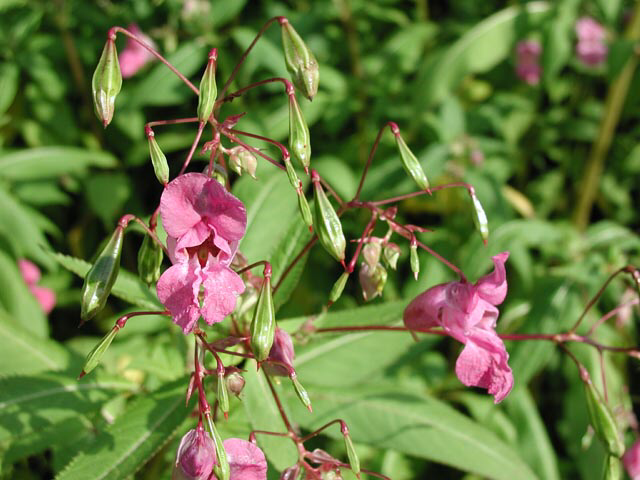
INVASIVE WATCH: HIMALAYAN BALSAM
This week were taking a look at a terrestrial invasive that looks extremely similar to some of Michigan’s favorite flowers the pale forget-me-not. The Himalayan balsam is on Michigan’s priority invasive species watchlist, even though it has been detected throughout portions of the Upper Peninsula, in areas such a Sugar Island in Gross’s Isle, near Sault Ste. Marie, Grand Marais, Munising, and Chatham.

The plant species originated in the Himalayan range of Asia, and historically was transported all over the world, making it today one of the most invasive plants in the world. Traditionally it was transported for purposes in the horticulture area, and more commonly as an ornamental due to its showy flower display. It can tolerate a wide variety of soils, but requires a high soil moisture. It is partially shame tolerant and can be found in lowland, riparian areas, including moist forests, swamps, stream sides, ditches, yards and gardens, and even roadside thickets.

Himalayan balsam can grow anywhere form three to six feet tall, and it has egg-shaped to elliptical shaped leaves. The stems are a purplish red color that’s smooth and hollow. Each stem can produce anywhere from five to ten showy flowers which bloom in the summer. The flowers have five petals which can be anywhere in color from purple to magenta, blue, pink, or even white.
It germinates early in the spring, and what makes it such a nuisance species is its seed dispersal. The fruit capsules explode when ripe and or touched; a single plant can produce and disperse anywhere from 800 to 2,500 seeds that can be dispersed through water, wind, animals and pollinators. The seeds are viable for 18 to 24 months, they can even float and germinate under water, which requires cold temperatures to break seed dormancy.
Having such showy flowers that have a high sugar content nectar, brings in a variety of pollinators, which include many different species of bees, moths, and wasps. The attraction of many insects increases the chances probability and chances of pollen deposition and seed production. This could lead to a reduction in fitness of neighboring species as the Himalayan balsam spreads aggressively and out competes native species for soil nutrients.
Keeping species like the Himalayan balsam localized and even better out of Michigan is an important key for maintaining our forests and habitats. It’s effects can be felt by a variety of species as it out competes native plant species. When it accomplishes that it alters the food availability for native animals and can have effects on populations, both in numbers and in locations. It can force both animals, plants and insects out of their natural zones, which can lead to displacement for many individuals. Keeping our natural resources happy and healthy is vital to both Michigan’s outdoor heritage and sensitive ecosystems.
This article is part of the ongoing series on invasive species funded in part with funds from the Michigan Invasive Species Grant Program through the Department of Natural Resources, Environmental Quality, and Agriculture and Rural Development
